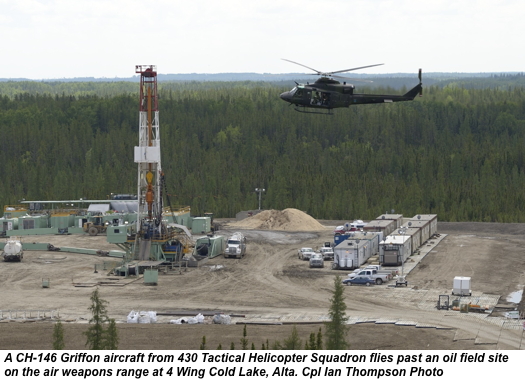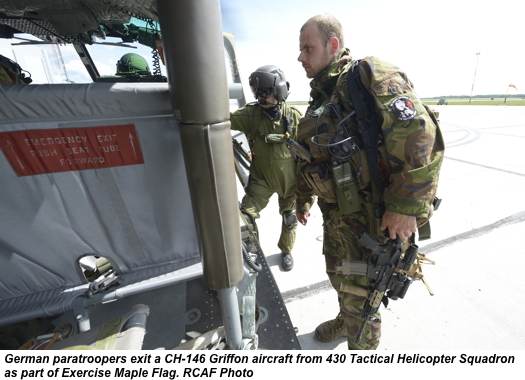For many participants and observers at Exercise Maple Flag, the most tangible thrill lies in the multitude of fast aircraft that are characteristic of the exercise. But this year, barely noticeable amid the roar of the jet aircraft launching twice daily, the heavy, percussive “whomp-whomp” sound of CH-146 Griffon helicopters could also be heard.
Composed of four CH-146 Griffon helicopters and 27 members, including eight pilots from five different tactical helicopter squadrons, five flight engineers and 11 aircraft technicians, the group, dubbed 430 Squadron detachment, conducted numerous missions throughout its two-week participation, which included conducting reconnaissance flights for airborne troops, many of whom were from participating nations such as the Netherlands. Many of these missions were carried out at the Cold Lake Air Weapons Range, where “enemy” fighters and simulated ground surface-to-air missile sites engaged them in an attempt to bring them down.
The participation of tactical helicopters such as the Griffon added a whole new dimension to Exercise Maple Flag 46 (Ex MF46), but one that Colonel Patrice Laroche, commander of 4 Wing Cold Lake, Alta., sees as an expanding prospect for future exercises, especially with the arrival of the RCAF’s new fleet of CH-147F Chinook medium-to-heavy-lift helicopters.
“The arrival of the Chinook is going to be a bit of a game-changer,” he said. “Its ability to move large numbers of troops in the air, the way they did in Afghanistan and in large numbers, will be able to be repeated in our training.”
With the CH-147F’s arrival, air mobility will become a more evident component of the exercise, which previously couldn’t be incorporated on any significant scale. Due to limitations in the number of passengers it can carry, the CH-146 Griffon is mostly used to support the movement of troop happening on the ground and not necessarily to transport them in any significant number.
Nevertheless, 430 Squadron detachment’s commander, Captain Patrick Hollock, notes that although it may be limited in troop transport capacity, the Griffon brings many other capabilities to the fight; capabilities that were demonstrated throughout the exercise, fulfilling both combined and joint requirements. From reconnaissance and surveillance using the MX-15 sensor, to specialised troop insertion via parachute, rappel, fast rope, or diver casting (where the helicopter flies in low over water, divers sit on the edge of the open door and jump in the water from the helicopter) to troop in-contact support (support of troops who are in contact i.e. engaged with the enemy) using Close Combat Attack (CCA) (a coordinated attack by armed aviation against targets that are in close proximity to friendly forces) with a multitude of weapons (C-6 7.62mm machine gun, M-134 Dillon 7.62mm 6-barrel gattling gun, or GAU-21 .50 Cal machine gun), the Griffon proved its value, contributing enormously to the success of the exercise.
“We provided CCA support to the Dutch troops on multiple occasions, and had the opportunity to work with the United States Marine Corps, who provided a forward arming and refuelling point for the helicopters,” he explained.
The integration of rotary wing operations within this year’s exercise has been “highly successful,” according to Col Laroche. “I think it’s been beneficial to both groups because we all fly in the same airspace. Understanding what everybody brings to the fight is important, not just for the fighters trying to drop bombs with helicopters around, but also for the helicopters to understand what the fighters, transport aircraft and everybody else does. That makes integration of all the fighting synergy and the safety effectiveness that much better.”
While Canadian helicopters will be more evident in future Maple Flags, it is hoped that other countries may also decide to bring some along, although Col Laroche notes that there are challenges associated with that possibility. Additional airlift would be required to transport the helicopters, making their inclusion in the exercise much more costly for participating nations.
Capt Hollock says his detachment’s participation in Ex MF46 provided a whole new dimension to rotary wing training. “This was an excellent opportunity for crews to work with combined air operations in a non-permissive environment (an environment in which friendly forces anticipate obstructions to, or interference with, operations),” he said. “Our crews usually work more closely with the Army, and this exercise allowed them to develop a working relationship with the Air Force.”



